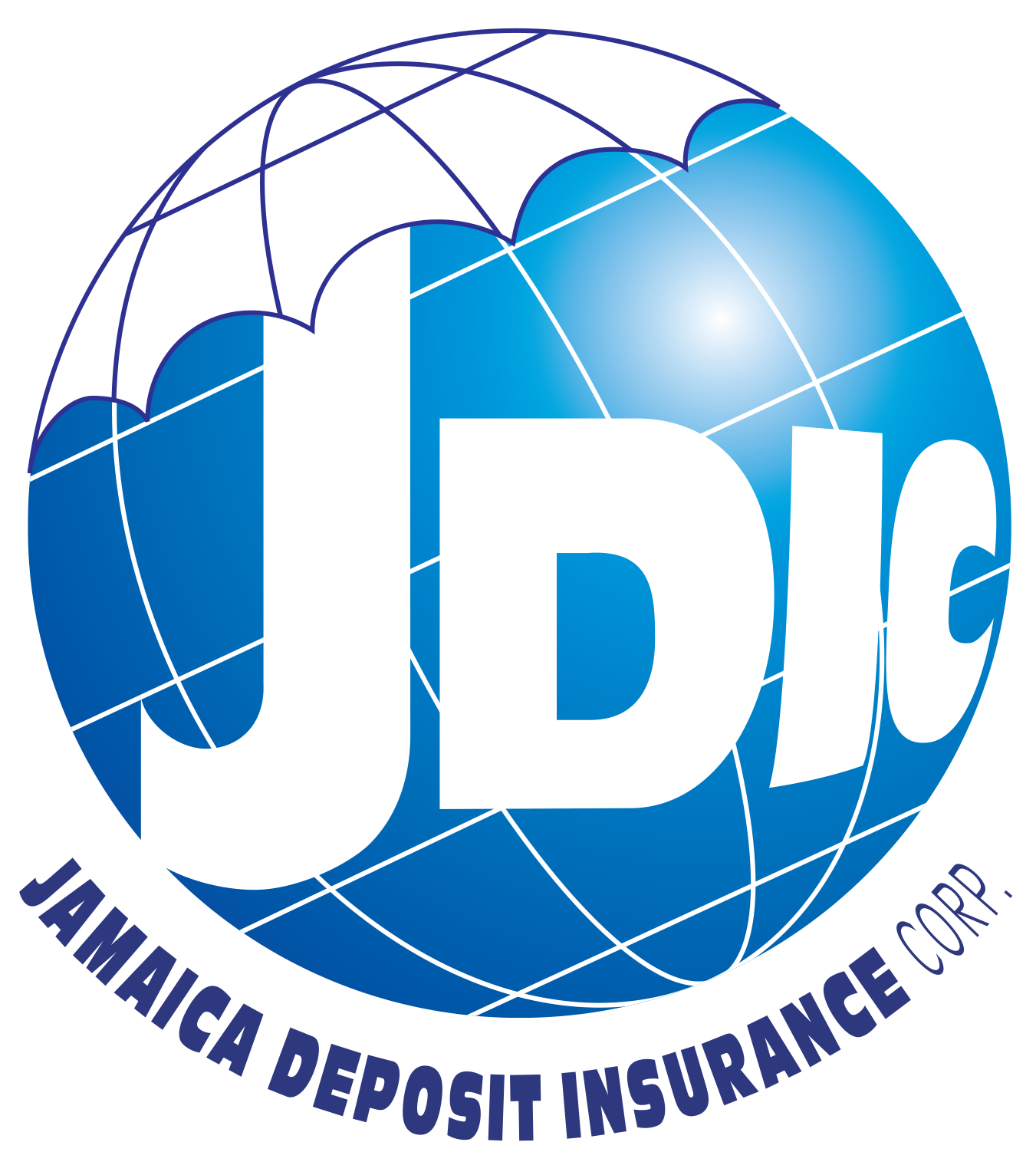General Deposit Insurance Coverage
It is a safety net set up primarily to protect depositors in case their bank or other insured financial institution fails or is unable to make payments on deposits.
Under the Deposit Insurance Act of 1998, the Jamaica Deposit Insurance Corporation (JDIC) is vested with the responsibility to manage the Scheme governed by this Act.
Under the Scheme, insurance premiums are paid into the Deposit Insurance Fund by policyholders, i.e. financial institutions covered by the Scheme. Resources from the Fund will be used to honour depositors’ claims in the event that a policyholder is unable to make payments on deposits.
The Scheme provides a formal system for the Government to deal with problems that may arise in the financial sector and should contribute to the restoration of confidence in the financial sector and encourage savings. Jamaica joins countries like Canada, Trinidad and Tobago, Germany, the United States of America, the United Kingdom, Venezuela, and India in setting up deposit insurance.
The majority of funds received by a deposit-taking financial institution are insured. These include:
- Savings & Chequing Accounts
- Time Deposits
- Certificates of Deposit, (ie. CDs)
- Managers’ Cheques, Money Orders, Drafts
- Travellers Cheques Issued By The Financial Institution
- A Share In a Building Society (other than capital shares, preference shares)
Depositors are ultimately responsible for the choices they make about where to deposit their funds. With the introduction Deposit Insurance, the 100% Government guarantee which depositors benefited from ceases to exist.
The gains or losses resulting from your choice about where to put your money and in what kinds of accounts, are yours. It is therefore very important that you take great care in exercising that choice and select a well-managed institution in which to deposit your funds.
Either by cheques directly to depositors or by transferring funds to another policyholder which pays out on behalf of the Corporation.
Not all monies placed with financial institutions covered by the Scheme are insured. For example, JDIC does not insure: Commercial Paper, Brokered/Managed Funds, Debentures and Deposits made by other policyholders, statutory bodies or the Government of Jamaica.
Financial institutions not supervised by the Bank of Jamaica are not insured by the Corporation. These include, Credit Unions, Money Market Brokers, Investment Firms and Life Insurance Companies
Not necessarily. JDIC will issue a certificate to depositors for the portion of the deposits not insured. This certificate must be presented to the liquidator who will make pro-rated payments to depositors when the failed institution’s assets are available for distribution.
JDIC will pay depositors as soon as possible. In any event, JDIC must pay the insured sum within three months of the failure of the institution. It not, the Corporation pays interest, but only after the three months have passed.
That depends. You cannot increase coverage by dividing your monies among several accounts in the same ownership category. The most common ownership categories are Individual, Joint, Business and Trust Accounts.
Yes. Deposits by the same depositor in different institutions are insured separately and therefore enjoy coverage of $1,200,000 per depositor. However, to gain this additional protection, deposits must be held in separate institutions and not different branches of the same institutions.
Yes. So long as your deposits are within the limit of insurance coverage which is currently $1,200,000 (interest and principal combined). Eligible depositors who hold deposits of $1,200,000 or less, will be paid in full.
Yes. But payments are made in Jamaica and in Jamaican currency.
No. Each institution (policyholder) will contribute to the Deposit Insurance Fund through annual premiums.
JDIC insures deposits in some, but not all financial institutions. To make sure your money is protected, look for a Certificate of Deposit Insurance which must be prominently displayed in the head office and branches of all policyholders. Insured institutions include:
- Commercial Banks
- Merchant Banks, Trust Companies and Finance houses
- Building Societies
Ownership
A joint account is owned by two or more persons in which:
- Each co-owner has signed the account’s signature card.
- Each co-owner may withdraw monies from the account.
Joint accounts are insured separately from individual accounts. The maximum coverage for all deposits having the same joint owners at each institution covered by the Scheme is $1,200,000 (collectively, not per individual owner). Each person’s share in a joint account will be considered equal unless stated otherwise on the deposit records.
Deposits held in trust are insured separately from deposits owned individually by the trustee or the beneficiary provided that the records of the institutions:
- State that the deposit is held in trust;
- Identify the name and address of the trustee (s) and
- Identify the name and address of the beneficiary or beneficiaries.
At each institution, all eligible deposits having both the same trustee and the same beneficiary are combined and the total is insured to a maximum of $1,200,000.
Funds deposited by a company, partnership, or association are insured up to a maximum of $1,200,000. Business accounts are insured separately from the personal accounts of their shareholders, partners, or members. Accounts owned by a business but designated for different purposes are not separately insured. These will be added and insured up to a maximum of $1,200,000. In the case of sole proprietorship, ie, the business is individually owned, its account will be treated as an individual one and will be added to his business account and insured up to a maximum of $1,200,000.
Each beneficiary of a trust or nominee account is insured up to the prescribed coverage limit of $1,200,000, separately from the other deposits that are held by the beneficiary in other ownership categories and other trust accounts. However, all trust or nominee accounts created with respect to the same settlors; grantors; trustees; nominees and beneficiaries in the same institution will be added together and insured up to the prescribed coverage limit of $1,200,000.
For trust or nominee accounts with one beneficiary, there will be no annual disclosure requirement.
Pursuant to the Deposit Insurance (Joint, Trust and Nominee Accounts) Regulations, 2014 and the Proceeds of Crime (Money Laundering Prevention) Regulations, 2007, the customer information for all parties to the trust or nominee account must be disclosed to the Policyholder. The customer information will also be recorded in the Policyholder’s banking information system or disclosed to and maintained by any of the persons identified as exempted from the disclosure for trust and nominee accounts under the Deposit Insurance (Joint, Trust and Nominee Accounts) Regulations, Paragraph 10, “Exemptions from disclosure for trust and nominee accounts) .
If the information for the beneficiaries or the amount or percentage entitlement or beneficial interest cannot be determined, the insurance coverage for the entire trust or nominee account will be limited to a maximum of $1,200,000.
The Corporation will make payment in the name of the trustees or nominees as the case may be for the respective beneficiaries.
Accounts held by a different trustee or nominee for the same beneficiaries at the same Institution are insured separately up to the prescribed coverage limit of$1,200,000.
Accounts held by the same trustee or nominee for different beneficiaries at the same Institution are insured separately up to the prescribed coverage limit of$1,200,000.
Accounts held by the same trustee or nominee for the same settlor and beneficiary at the same Institution will be combined and insured up to the prescribed coverage limit of $1,200,000.
The beneficiary will receive separate deposit insurance coverage up to the prescribed coverage limit of $1,200,000 for each trust or nominee account if the monies are held for a different nominee or settlor.
If a trustee or nominee fails to disclose that the monies are held for the benefit of a beneficiary (i.e. to the financial institution upon opening a trust or nominee account), the Corporation shall not provide separate deposit insurance coverage for each beneficiary. Therefore, if an institution fails, the Corporation will treat the account as an account maintained by the trustee or nominee in their own right and capacity and payment will be made to the trustee or nominee for an amount not exceeding the prescribed coverage limit of $1,200,000.
Financial institutions insured by the JDIC are required to notify trust and nominee account holders annually about the information that they must disclose. A trustee or nominee that holds funds for multiple beneficiaries needs to supply the required information to the financial institution. This will ensure that the beneficiaries receive separate deposit insurance coverage if the Policyholder fails. It is the responsibility of the trustee or nominee to guarantee that all required disclosures are made to the financial institution and that the information is accurate and complete.
In the case of a bank failure, the trustee or nominee is given the opportunity to provide any updated information within 14 days of the failure, provided that full disclosure was made upon opening the trust or nominee account.
Policyholders are required to remind the trustee or nominee with two or more beneficiaries, by notice given no later than October 31st of each year to make the required disclosure to the Policyholder. The trustee or nominee must therefore inform the Policyholder at least once per year within the time stated in the notice.
The annual disclosure is to be submitted to the Policyholder and not to the JDIC.
JDIC provides deposit insurance coverage for the beneficiaries of trust or nominee accounts separately from other deposits held by the beneficiary or the trustee or nominee in their own name and in separate ownership categories at the same institution. For this distinct protection to apply, the following conditions must be satisfied:
- The depositor (trustee or nominee) must make the required disclosure to the institution upon opening the trust or nomine account.
- The trustee or nominee must disclose all the relevant customer information for all the parties to the trust or nominee arrangement to the institution. Customer Information includes:
- The trustee’s or nominee’s full name; current address; taxpayer registration number (TRN) or other reference number; date and place of birth or date of incorporation (in the case of a business entity/company) and any other information relating to the identification of the trustee or nominee that the Corporation shall specify;
- Information establishing the identity of the settlor, legal owner or other persons who exercise effective control of the legal arrangement and any other information the Corporation shall specify.
- The full name; TRN or other reference number; date and place of birth or date of incorporation (in the case of a business entity/company) of the beneficial owner and any other information the Corporation shall specify.
- If the trust or nominee account contains more than one beneficiary, the particulars of the amount or percentage of the beneficial entitlement or interest of each beneficiary must be disclosed on the records of the institution.
The JDIC will not provide separate deposit insurance coverage for any beneficiary in a trust or nominee account if, in the opinion of the Corporation, the trust or nominee account exists primarily for the purpose of obtaining or increasing deposit insurance coverage.


